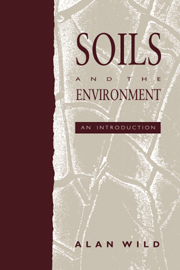Book contents
- Frontmatter
- Contents
- Preface
- Acknowledgements
- Units, symbols and general information
- 1 Introduction: soil in a natural and man-made environment
- A Soil properties and processes
- 2 The soil components
- 3 Development of soils
- 4 Sorptive properties of soils
- 5 Organisms and soil processes
- 6 Movement of water, air, solutes and heat in soil
- B Soils in relation to the environment
- Suggestions for further reading
- Index
6 - Movement of water, air, solutes and heat in soil
Published online by Cambridge University Press: 06 January 2010
- Frontmatter
- Contents
- Preface
- Acknowledgements
- Units, symbols and general information
- 1 Introduction: soil in a natural and man-made environment
- A Soil properties and processes
- 2 The soil components
- 3 Development of soils
- 4 Sorptive properties of soils
- 5 Organisms and soil processes
- 6 Movement of water, air, solutes and heat in soil
- B Soils in relation to the environment
- Suggestions for further reading
- Index
Summary
Introduction
The soil components described in Chapter 2 include solids (minerals and organic matter), liquids (water) and gases (the soil air). Of these, water can readily be seen to move when rain falls on dry soil. The water wets the soil surface and if a vertical face is cut into the soil the wetting front can often be observed as a colour change. If more rain falls and the soil is free-draining the water passes into drains or percolates through the subsoil and may move into underlying porous rock. If the rock is not porous the water will emerge as surface seepage on hill slopes and run into rivers.
The soil solids can also move, most obviously when they are blown by wind or washed down slopes by rainwater. They also move in situ during freezing and thawing, during swelling and shrinking, and by the activities of the soil fauna, especially earthworms and termites. The flow of gas into and out of soil cannot be observed by eye (the gas bubbles that emerge from swamps are an exception), but its occurrence can be demonstrated by collecting carbon dioxide that is evolved from soil in a closed flask.
Soil also has thermal energy, which we refer to as heat, changes in which manifest themselves as changes in temperature. The soil surface gains heat from incoming solar radiation and loses it by back-radiation and convection to the atmosphere, by evaporating water and by transfer down the profile. Solutes also move: they diffuse and they are carried in the flow of water.
- Type
- Chapter
- Information
- Soils and the Environment , pp. 89 - 106Publisher: Cambridge University PressPrint publication year: 1993



